Related Research Articles

William Maxwell "Bill" Gaines was an American publisher and co-editor of EC Comics. Following a shift in EC's direction in 1950, Gaines presided over what became an artistically influential and historically important line of mature-audience comics. He published the satirical magazine Mad for over 40 years.
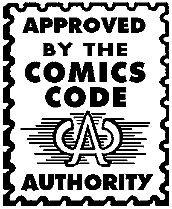
The Comics Code Authority (CCA) was formed in 1954 by the Comics Magazine Association of America as an alternative to government regulation. The CCA enabled comic publishers to self-regulate the content of comic books in the United States. The code was voluntary, as there was no law requiring its use, although some advertisers and retailers looked to it for reassurance. Some publishers, including Dell, Western, and Classics Illustrated, never used it. Its code, commonly called "the Comics Code", lasted until the early 21st century. The CC formation followed a moral panic centered around a series of Senate hearings and the publication of psychiatrist Fredric Wertham's book Seduction of the Innocent.
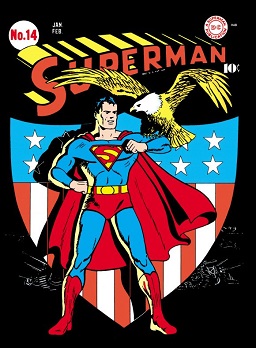
The Golden Age of Comic Books describes an era in the history of American comic books from 1938 to 1956. During this time, modern comic books were first published and rapidly increased in popularity. The superhero archetype was created and many well-known characters were introduced, including Superman, Batman, Robin, Captain Marvel, Captain America, and Wonder Woman.

Fredric Wertham was a German-American psychiatrist and author. Wertham had an early reputation as a progressive psychiatrist who treated poor black patients at his Lafargue Clinic at a time of heightened discrimination in urban mental health practice. Wertham also authored a definitive textbook on the brain, and his institutional stressor findings were cited when courts overturned multiple segregation statutes, most notably in Brown v. Board of Education.

Carey Estes Kefauver was an American politician from Tennessee. A member of the Democratic Party, he served in the U.S. House of Representatives from 1939 to 1949 and in the U.S. Senate from 1949 until his death in 1963.

Seduction of the Innocent is a book by German-born American psychiatrist Fredric Wertham, published in 1954, that warned that comic books were a negative form of popular literature and a serious cause of juvenile delinquency. The book was taken seriously at the time in the United States, and was a minor bestseller that created alarm in American parents and galvanized them to campaign for censorship. At the same time, a U.S. Congressional inquiry was launched into the comic book industry. Subsequent to the publication of Seduction of the Innocent, the Comics Code Authority was voluntarily established by publishers to self-censor their titles. In the decades since the book's publication, Wertham's research has been disputed by scholars.
Mainline Publications, also called Mainline Comics, was a short-lived, 1950s American comic book publisher established and owned by Jack Kirby and Joe Simon.
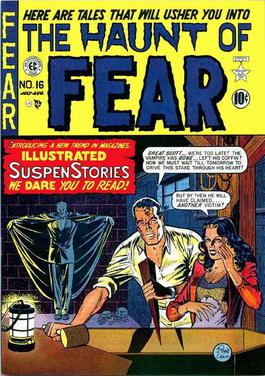
The Haunt of Fear was an American bi-monthly horror comic anthology series published by EC Comics, starting in 1950. Along with Tales from the Crypt and The Vault of Horror, it formed a trifecta of popular EC horror anthologies. The Haunt of Fear was sold at newsstands beginning with its May/June 1950 issue.

John Thomas Alexis Craig, was an American comic book artist notable for his work with the EC Comics line of the 1950s. He sometimes used the pseudonyms Jay Taycee and F. C. Aljohn.
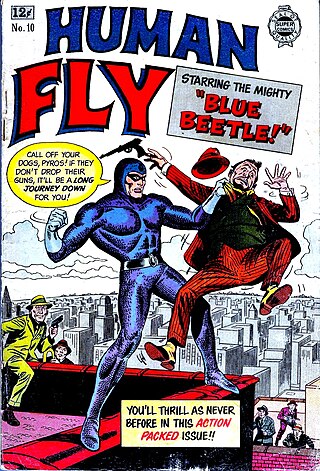
I.W. Publications was a short-lived comic book publisher in the late 1950s and early 1960s. The company was part of I.W. Enterprises, and named for the company's owner, Israel Waldman. I.W. Publications was notable for publishing unauthorized reprints of other publishers' properties. Usually these companies were already out of business.
In psychology, a Superman complex is an unhealthy sense of responsibility, or the belief that everyone else lacks the capacity to successfully perform one or more tasks. Such a person may feel a constant need to "save" others and, in the process, takes on more work on their own.
The Association of Comics Magazine Publishers (ACMP) was an American industry trade group formed in the late 1940s to regulate the content of comic books in the face of public criticism during that time. It was a precursor to the Comics Magazine Association of America, and the ACMP Publishers Code served as the template for a more detailed set of rules enforced by the CMAA's Comics Code Authority.
Chamber of Chills is the name of two anthology horror comic books, one published by Harvey Publications in the early 1950s, the other by Marvel Comics in the 1970s.
John Leonard Goldwater co-founded MLJ Comics, and served as editor and co-publisher for many years. In the mid-1950s he was a key proponent and custodian of the comic book censorship guidelines known as the Comics Code Authority.

The Brooklyn Thrill Killers were a group of teenage boys who were convicted of killing one man and accused of killing another and committed acts of assault and torture against several other people in Brooklyn, a borough of New York City during the summer of 1954. The case attracted considerable media attention in the United States. It also fueled the controversy over comic books, which were accused at the time of causing sexual perversion and juvenile delinquency.
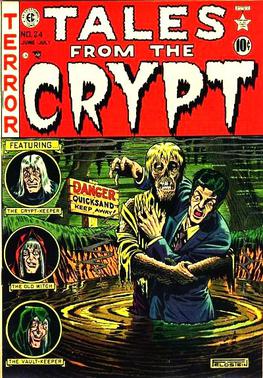
Horror comics are comic books, graphic novels, black-and-white comics magazines, and manga focusing on horror fiction. In the US market, horror comic books reached a peak in the late 1940s through the mid-1950s, when concern over content and the imposition of the self-censorship Comics Code Authority contributed to the demise of many titles and the toning down of others. Black-and-white horror-comics magazines, which did not fall under the Code, flourished from the mid-1960s through the early 1980s from a variety of publishers. Mainstream American color comic books experienced a horror resurgence in the 1970s, following a loosening of the Code. While the genre has had greater and lesser periods of popularity, it occupies a firm niche in comics as of the 2010s.

Star Publications, Inc. was a Golden Age American comic book publisher, operating during the years 1949–1954. Founded by artist/editor L. B. Cole and lawyer Gerhard Kramer, Star specialized in horror, crime, and romance comics — but also published funny animal stories. Star was originally based in New York City before relocating to Buffalo, New York.
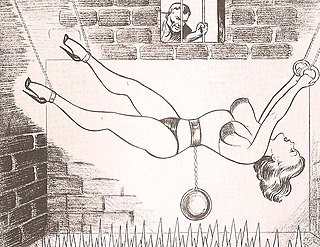
Nights of Horror is an American series of fetish comic books, created in 1954 by publisher Malcla, drawn by comic artist Joe Shuster, who is also one of the original creators of Superman. The comic stories were written by an author under the pseudonym Clancy, who also used other pseudonyms for different issues of the books. The stories are based on situations of BDSM, bondage, torture, and sexual slavery, featuring both men and women as the tormentors and victims. The series was important in the conviction of Jack Koslow in 1954, during the trial of the Brooklyn Thrill Killers. The books themselves were seized and banned first by New York City, then by the State of New York for violating obscenity laws, and the case went to the Supreme Court of the United States. The Court determined that the ban was not in violation of First Amendment rights, and upheld New York's request for destroying copies of Nights of Horror. Shuster was never named as the illustrator until Gerard Jones published the information in 2004.
Roy Early Blick was the director of the Morals Division of the Metropolitan Police Department of the District of Columbia (MPD) in the United States during the mid-twentieth-century. He oversaw investigation of and apprehension for offenses related to burlesque, pornography, child pornography, and other obscenity and indecency, prostitution, crimes of "sex perversion" including homosexuality, and gambling. Even before becoming director of the Morals Division, during his preceding career with the MPD, he was consulted by US federal lawmakers, testified before Congress on several occasions, and worked with the FBI on related law enforcement matters. Freedom of Information Act lawsuits in the twenty-first century revealed previously-classified documents indicating frequent meetings and correspondence between the Central Intelligence Agency and Blick during his service as a police official.

Josette Frank was an American children's literature expert and educational consultant. Frank spent most of her adult life working for the Child Study Association of America (CSAA), a leading authority on child development from the 1920s to the 1960s. Frank was engaged as the CSAA's child reading expert and published a parental literary guide titled What Books For Children? in 1937 with a new edition in 1941. Due to her progressive views about parental supervision of children's reading, Frank became one of the significant pro-comics voices during the American anti-comics movement of the 1950s, for which she received praise and criticism.
References
Bibliography
- Beaty, Bart (2005). Fredric Wertham and the Critique of Mass Culture. University Press of Mississippi, ISBN 1-57806-819-3.
- Nyberg, Ami Kiste (1998). Seal of Approval: The History of the Comics Code, University Press of Mississippi, ISBN 0-87805-975-X.
- Juvenile Delinquency (Comic Books) hearings before the United States Senate Committee on the Judiciary, Subcommittee To Investigate Juvenile Delinquency in the U.S., Eighty-Third Congress, second session, on Apr. 21, 22, June 4, 1954. (OCLC Worldcat link to 5320509 or 27331381)